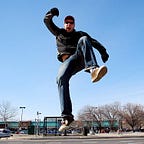Luces Encendidas #6: La Burbuja/The Bubble
By day, there are three modes by which the staff and volunteers engage with the kids in the shelter. Those who don’t speak Spanish issue one-word commands (ID* [as in, “I need to check yours for the head count”], fila [“get in line”], etc.) and take one-word requests (usually baño [need to go to the bathroom] or médico [need to go to the nurse’s station]), otherwise maintaining a polite but vigilant distance. The Spanish-fluent adults engage with their charges in a familial way, chatting up the kids like — depending on their age — a parental or big brother/sister would.** The Spanish-passable (like me) get tapped to help nonspeakers where we can, and have some moderate interaction with the kids, but it’s still pretty formal.
*[One of the first, most weirdly disappointing things I learned here is that the colloquial term for identity badges is just “el ID,” pronounced aidí as in English.]
**[I was recently paired up with a young Puerto Rican lady who filled up some downtime by engaging about a dozen kids with a DIY version of Scattergories. One of the kids put “Bosnia” for a country that starts with B, so rest assured they know things. (True to form, I struggled to think of a vegetable that starts with S en español, but I did come up with an animal that starts with W: walabí.)]
Again, all that is by day. By night we sit and hold vigil over our designated cohort. Those pods at the edge of the room have some breathing space, so the adults can sit or stand up to a dozen feet away while keeping watch. All those on the interior, however, require pulling up a chair — or pacing, if on foot — within three feet of the cots that represent the extent of the kids’ personal space while they’re here. The cots within each pod are about two feet apart on each side.
Together, these social (by-day) and spatial (by-night) setups determine the kids’ “bubble” of comfort. (Hence the title.) I’ve mentioned before that there’s virtually no privacy for them while they’re here: The only times they’re not in view of an adult are when they’re in a toilet or shower stall. The closest approximation to escaping notice they have otherwise is the camouflage of hanging out in large groups, since most of the kids are wearing the standard-issue clean gray sweats they were given when they arrived here. (Laundry is a whole ‘nother topic.)
I’ve been thinking about the idea that in dense places like New York City, where public life doesn’t allow for a lot of personal space, people cope by mentally adopting a small but impermeable “cocoon” around themselves— i.e., this narrow radius around me is my space, and I won’t worry about the people just outside it. I feel like the kids here have had to adopt a similar mentality: There is a constant flux of adults (strangers mostly,*** who swap out every 8–12 hours) hovering very close by throughout the day, and everyone has to make some mental effort to make peace with that.
***[The way the shelter is run, most staff and volunteers are assigned to pods as scarcity and necessity dictate: basically, go wherever there is a need right now. Some volunteers, however, have managed to finagle themselves the ability to get assigned to the same pod of kids each day, which works wonders for making connection.]
For an environment that sits nebulously in between “summer camp” and “penal colony” in overall feel, it’s no surprise that boundaries are a salient theme. Sometimes they’re explicit: We don’t touch the kids, partly for hygienic reasons (both COVID and scabies outbreaks have been identified) and partly because there is no room for even the implication of abuse. But it’s the implicit boundaries — the bubbles we form around ourselves, based both on the space we have to operate in and the need to admit or ignore anyone who approaches — that give much more shape to how we conduct ourselves in a situation outside virtually everyone’s control.
